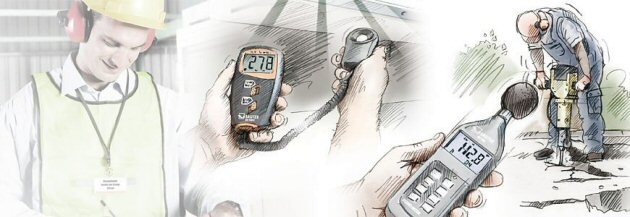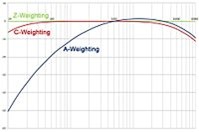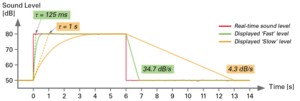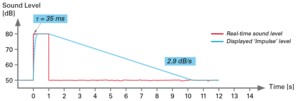A sound level meter is used for acoustic (sound that travels through air) measurements. It is commonly a hand-held instrument with a microphone. The diaphragm of the microphone responds to changes in air pressure caused by sound waves. That is why the instrument is sometimes referred to as a Sound Pressure Level (SPL) Meter. This movement of the diaphragm, i.e. the sound pressure deviation (pascal Pa), is converted into an electrical signal (volts V).
A microphone is distinguishable by the voltage value produced when a known, constant sound pressure is applied. This is known as the microphone sensitivity. The instrument needs to know the sensitivity of the particular microphone being used. Using this information, the instrument is able to accurately convert the electrical signal back to a sound pressure, and display the resulting sound pressure level (decibels dB SPL).
Sound level meters are commonly used in noise pollution studies for the quantification of different kinds of noise, especially for industrial, environmental and aircraft noise. The current international standard that specifies sound level meter functionality and performances is the IEC 61672-1:2013. However, the reading from a sound level meter does not correlate well to human-perceived loudness, which is better measured by a loudness meter. Specific loudness is a compressive nonlinearity that depends on level and also frequency, which can be calculated in a number of different ways.
Types
The IEC 61672-1 specifies "three kinds of sound measuring instruments". They are the "conventional" sound level meter, the integrating-averaging sound level meter, and the integrating sound level meter.
The standard sound level meter can be called an exponentially averaging sound level meter as the AC signal from the microphone is converted to DC by a root-mean-square (RMS) circuit and thus it must have a time constant of integration; today referred to as the time-weighting. Three of these time-weightings have been internationally standardized, 'S' (1 s) originally called Slow, 'F' (125 ms) originally called Fast and 'I' (35 ms) originally called Impulse. Their names were changed in the 1980s to be the same in any language. I-time-weighting is no longer in the body of the standard because it has little real correlation with the impulsive character of noise events.
The output of the RMS circuit is linear in voltage and is passed through a logarithmic circuit to give a readout linear in decibels (dB). This is 20 times the base 10 logarithm of the ratio of a given root-mean-square sound pressure to the reference sound pressure. Root-mean-square sound pressure being obtained with a standard frequency weighting and standard time weighting. The reference pressure is set by International agreement to be 20 micropascals for airborne sound. It follows that the decibel is, in a sense, not a unit, it is simply a dimensionless ratio; in this case the ratio of two pressures.
An exponentially averaging sound level meter, which gives a snapshot of the current noise level, is of limited use for hearing damage risk measurements; an integrating or integrating-averaging meter is usually mandated. An integrating meter simply integrates—or in other words 'sums'—the frequency-weighted noise to give sound exposure and the metric used is pressure squared times time, often Pa²·s, but Pa²·h is also used. However, because the unit of sound was historically described in decibels, the exposure is most often described in terms of sound exposure level (SEL), the logarithmic conversion of sound exposure into decibels.
Note: in acoustics all 'levels' are in decibels
Classes
IEC standards divide sound level meters into two "classes". Sound level meters of the two classes have the same functionality, but different tolerances for error. Class 1 instruments have a wider frequency range and a tighter tolerance than a lower cost, Class 2 unit. This applies to both the sound level meter itself as well as the associated calibrator. Most national standards permit the use of "at least a Class 2 instrument". For many measurements, it is not necessary to use a Class 1 unit; these are best employed for research and law enforcement.
Class 1 accuracy bellow 1,5 dB
Class 2 accuracy between 1,5 and 3 dB
Measurements
Sound Level Label examples
Description Label
- Level A-weighted equivalent LAeq
- Level A-weighted Fast maximum LAFmax
- Level C-weighted Slow minimum LCSmin
- Level Z-weighted Impulse maximum LZImax
Level
For labels, the first letter is always an L. This simply stands for Level, as in the sound pressure level measured through a microphone or the electronic signal level measured at the output from an audio component, such as a mixing desk.
Frequency weighting
A, C and Z frequency weightings for sound
The second letter indicates the frequency weighting. 'Pattern Approved' sound level meters offer noise measurements with A, C and Z frequency weighting.
Z-Weighting represents the actual sound produced. A-Weighting, with less lower and higher frequencies, and a slight boost in the mid-range, represents what humans are capable of hearing. C-Weighting, more sensitive to the lower frequencies, represents what humans hear when the sound is loud (over 100 dB).
The IEC 61672-1:2013 mandates the inclusion of an A-frequency-weighting filter in all sound level meters, and also describes C and Z (zero) frequency weightings. The older B and D frequency weightings are now obsolete and are no longer described in the standard.
In almost all countries, the use of A-frequency-weighting is mandated to be used for the protection of workers against noise-induced hearing loss. The A-frequency curve was based on the historical equal-loudness contours and while arguably A-frequency-weighting is no longer the ideal frequency weighting on purely scientific grounds, it is nonetheless the legally required standard for almost all such measurements and has the huge practical advantage that old data can be compared with new measurements. It is for these reasons that A-frequency-weighting is the only weighting mandated by the international standard, the frequency weightings 'C' and 'Z' being optional fitments.
Originally, the A-frequency-weighting was only meant for quiet sounds in the region of 40 dB sound pressure level (SPL), but is now mandated for all levels. C-frequency weighting is however still used in the measurement of the peak value of a noise in some legislation, but B-frequency weighting – a halfway house between 'A' and 'C' has almost no practical use. D-frequency-weighting was designed for use in measuring aircraft noise when non-bypass jets were being measured and after the demise of Concord, these are all military types. For all civil aircraft noise measurements, A-frequency-weighting is used as is mandated by the ISO and ICAO standards.
Time Weighting
Graphs of Fast, Slow and Impulse time weightings applied so that sound levels measured are easier to read on a sound level meter.
If the third letter is F, S or I, this represents the time weighting. F = Fast, S = Slow, I = Impulse. Time weighting is applied so that levels measured are easier to read on a sound level meter. The time weighting dampens sudden changes in levels, thus creating a smoother display.
The graph indicates how this works. In this example, the input signal suddenly increases from 50 dB to 80 dB, stays there for 6 seconds, then disappears just as suddenly.
A Slow measurement (yellow line) will take approximately 5 seconds (attack time) to reach 80 dB and around 6 seconds (decay time) to drop back down to 50 dB. S is appropriate when measuring a signal that fluctuates a lot.
A Fast measurement (green line) is quicker to react. It will take approximately 0.6 seconds to reach 80 dB and just under 1 second to drop back down to 50 dB. F may be more suitable where the signal is less impulsive.
The decision to use Fast or Slow is often reached by what is prescribed in a standard or a law.
An Impulse measurement (blue line) will take approximately 0.3 seconds to reach 80 dB and over 9 seconds to drop back down to 50 dB. The impulse response, I can be used in situations where there are sharp impulsive noises, such as when measuring fireworks or gunshots.
LAT or Leq: Equivalent continuous sound level
Graph of LAeq sound level measurement calculated over 5 minutes
eq = equivalent. Equivalent values are a form of time weighting that is easier to read on a display than the instantaneous sound level.
If you look at these graphs of sound level over time, the area under the blue curve represents the energy. The horizontal red line drawn to represent the same area under the blue curve, gives us the LAeq. That is the equivalent value or average of the energy over the entire graph.
LAeq is not always a straight line. If the LAeq is plotted as the equivalent from the beginning of the graph to each of the measurement points, the plot is shown in the second graph.
Sound exposure level—in decibels—is not much used in industrial noise measurement. Instead, the time-averaged value is used. This is the time average sound level or as it is usually called the 'equivalent continuous sound level' has the formal symbol LAT as described in paragraph 3,9 "Definitions" of IEC 61672-1 where many correct formal symbols and their common abbreviations are given. These mainly follow the formal ISO acoustic definitions. However, for mainly historical reasons, LAT is commonly referred to as Leq.
Formally, LAT is 10 times the base 10 logarithm of the ratio of a root-mean-square A-weighted sound pressure during a stated time interval to the reference sound pressure and there is no time constant involved. To measure LAT an integrating-averaging meter is needed; this in concept takes the sound exposure, divides it by time and then takes the logarithm of the result.
Short Leq
An important variant of overall LAT is "short Leq" where very short Leq values are taken in succession, say at 1/8 second intervals, each being stored in a digital memory. These data elements can either be transmitted to another unit or be recovered from the memory and re-constituted into almost any conventional metric long after the data has been acquired. This can be done using either dedicated programs or standard spreadsheets. Short Leq has the advantage that as regulations change, old data can be re-processed to check if a new regulation is met. It also permits data to be converted from one metric to another in some cases. Today almost all fixed airport noise monitoring systems, which are in concept just complex sound level meters, use short Leq as their metric, as a steady stream of the digital one second Leq values can be transmitted via telephone lines or the Internet to a central display and processing unit. Short Leq is a feature of most commercial integrating sound level meters—although some manufacturers give it many different names.
Short Leq is a very valuable method for acoustic data storage; initially, a concept of the French Government's Laboratoire National d'Essais (ref 1), it has now become the most common method of storing and displaying a true time history of the noise in professional commercial sound level meters. The alternative method, which is to generate a time history by storing and displaying samples of the exponential sound level, displays too many artifacts of the sound level meter to be as valuable and such sampled data cannot be readily combined to form an overall set of data.
Until 2003 there were separate standards for exponential and linear integrating sound level meters, (IEC 60651 and IEC 60804—both now withdrawn), but since then the combined standard IEC 61672 has described both types of meter. For short Leq to be valuable the manufacturer must ensure that each separate Leq element fully complies with IEC 61672.
Graph of an LAFmax sound level measurement calculated every minute
Lmax and Lmin
If the words max or min appear in the label, this simply represents the maximum or minimum value measured over a certain period of time.
LCpk: peak sound pressure level
Most national regulations also call for the absolute peak value to be measured to protect workers hearing against sudden large pressure peaks, using either 'C' or 'Z' frequency weighting. 'Peak sound pressure level' should not be confused with 'MAX sound pressure level'. 'Max sound pressure level' is simply the highest RMS reading a conventional sound level meter gives over a stated period for a given time-weighting (S, F, or I) and can be many decibels less than the peak value. In the European Union, the maximum permitted value of the peak sound level is 140 dB(C) and this equates to 200 Pa pressure. The symbol for the A-frequency and S-time weighted maximum sound level is LASmax. For the C-frequency weighted peak it is LCpk or LC,peak.






